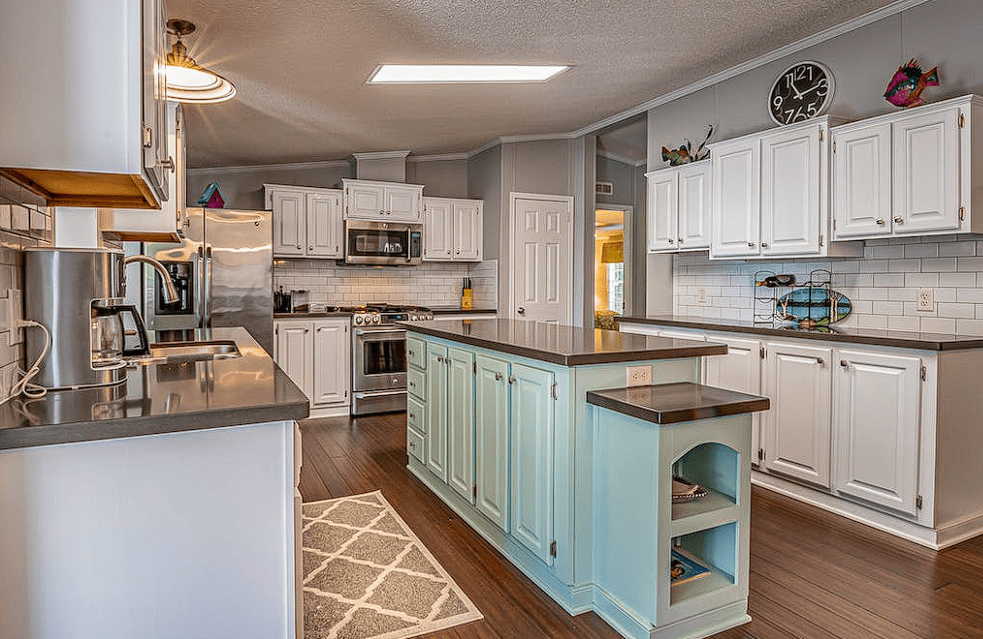Every home cook makes a difference in her family's mealtime routine. However, the vast majority of people have trouble keeping their kitchens clean and tidy. Having a kitchen that is well-maintained will not only extend the life of the cabinets, appliances, walls, flooring, etc., in a home with award-winning kitchen cabinets. The kitchen's shine will last for a long time, thanks to routine cleaning and maintenance.
In addition to their practical value, kitchen cabinets also add visual appeal to the room. They serve a dual purpose in our kitchen as both storage and decoration. However, cabinets can become discoloured and damaged and even pose health risks if they are not regularly cleaned of dirt, grease, and grime. This is why regular upkeep of kitchen cabinets is so important for their health and function. We'll go over why it's so important to keep your kitchen cabinets in good shape and offer some suggestions for doing just that.
Why Proper Maintenance of Kitchen Cabinets Is Important
Most of a family's time is spent in the kitchen, where meals are prepared, snacks are enjoyed, and conversations are shared. To keep things sanitary, keep the room looking nice, and keep the cabinets lasting as long as possible, regular cleaning is a must. Cleaning laminate and wood correctly requires the use of specialised cleaning products. Maintaining a clean and healthy kitchen starts with knowing how to clean your cabinets.
Keeping the outside of your cabinets clean is an important part of keeping your kitchen looking neat and organised. Cabinets can quickly become grimy and unappealing when touched frequently. In addition, modern society places a premium on cleanliness, which is especially important when dealing with raw meat. Cabinets that aren't properly cleaned can harbour bacteria and spread illness, so don't ignore this chore. Since bacteria can survive on hard surfaces for up to 24 hours, wiping them down frequently can help reduce the spread of illness in the workplace.
In addition, dirt and grime can wear down the finish of the cabinets over time. The dirt can seep through the finishing and permanently damage the wood, making repairs or a replacement very expensive. Maintaining a regular cleaning schedule for your cabinets is crucial to preventing this from happening and extending the life of your cabinets.
How Often Should You Be Cleaning Your Kitchen Cabinets
The Outside Of Your Cabinet: Every Two Weeks
The exterior of your kitchen cabinet consists of the door, any hardware attached to the door (such as handles, knobs, or sliders), and the frame and underbody (if the cabinet is wall-mounted). Due to the high frequency of their exposure, these should be cleaned every two weeks.
When cleaning the exterior of your cabinet, keep the following in mind:
Some harmful microorganisms can be transmitted from raw food, but luckily they can be killed by spraying an antibacterial solution on the area.
- If you want to protect your cabinet finish, don't use harsh chemicals or cleaners.
- You should also wipe down the knobs and handles of cabinets, as these are the parts of the cabinets that you interact with most often.
- After you've cleaned the surface thoroughly, a polishing cloth can bring out its shine.
- Use an all-purpose cleaner on tough stains like water or vinegar, but be careful not to scratch the cabinet's exterior in the process.
The material of your cabinet will also affect the type of cleaner you use; metal and glass cabinets can withstand strong chemicals when used sparingly, but wooden cabinets require special care to prevent deterioration. When in doubt, a quick wipe-down with a damp cloth and some dish soap should do the trick.
The Inside Of Your Cabinet: Every Three To Five Months
You might not think much about cleaning the interior of your kitchen cabinets, but every time you open and close them, dust and other debris can get trapped inside. Particularly problematic for the safety of the food stored in dirty kitchen cabinets is the presence of dust mites.
Some things to remember as you wipe down the inside of your kitchen cabinets:
- Make sure the interior is always dry to prevent the growth of mould.
- To clean thoroughly and get to every nook and cranny, you'll need to empty the cabinets first.
- Before reintroducing anything into the fridge, make sure you check the expiration date to prevent any bacteria from growing.
- To make future cleaning easier, you can use bath towels or other cloth covers to collect settling dust.
- After cleaning, let your cabinets "breathe" or air out for at least an hour or two.
- Food packaging and remnants of it should be discarded, and you should inspect the inside of your cabinets for mould and insects.
- Use a microfiber cloth to remove as much dust and dirt as possible without causing any damage during the cleaning process.
The interior of your kitchen cabinets may not need to be cleaned very often, but they should be cleaned thoroughly once a year to guarantee the safety and cleanliness of your food supply. Since bacteria and dirt can cling to the surfaces of dishes even after washing, it's not a good idea to store them inside the dishwasher.
Basic Cabinet Cleaning
Cabinets can be ruined by grease and grime buildup, ruining an otherwise brand-new kitchen's aesthetic. At least once every two weeks, or more often depending on the amount of use, wipe down cabinets with a soft cloth dampened with warm water to remove buildup. If you find that rinsing with water alone doesn't get the job done, try adding a few drops of mild dishwasher soap. When cleaning wood cabinets, always wipe in the grain. Remove any remaining moisture from the cabinets using a soft cloth.
If regular cleaning methods have failed to remove a stain or layer of grime, make a paste of baking soda and water. Scrub the stain with the paste-covered sponge until it is gone. Use water to clean, then a soft towel to dry. Another option for removing film or grime from kitchen cabinets is a solution of equal parts vinegar and water.
Products containing the following ingredients should be avoided because they can cause damage to cabinets:
- Petroleum-based products
- Solvents
- Bleach
- Strong detergents and soaps
- Nail polish remover
- Paint thinners
- Plastic brushes
- Steel wool
- Scoring Pad
- Ammonia
Tips to Care for Your Kitchen Cabinets
Set a Cleaning Schedule
The key to clean, dust-free kitchen cabinets is regular cleaning. If you don't put this preventative maintenance task on your calendar, you're likely to forget about it. Every two weeks, wipe down cabinet fronts and drawers, and every six months, clean the cabinets thoroughly.
Choose the Proper Tools
The kitchen's attention should be drawn to the cabinets. The visual appeal of a room can be diminished by the presence of even a small scratch. If you use the right equipment, cleaning your cabinets won't cause any damage. Cabinets are best cleaned with soft cloths and gentle brushes. Stay away from metal-tipped stiff brushes and abrasive sponges/scouring pads.
Start at the Top
Start with the upper cabinets for a time saver. Dust and grime can settle on your freshly cleaned lower cabinets if you leave them until last. Dust can be wiped off the tops of cabinet doors in a matter of seconds with a soft cloth. Dust the tops of the cabinets as well if they don't reach the ceiling. This task can be made easier by using a portable vacuum cleaner.
If you want to clean the fronts of your cabinets, use a mild cleanser or a solution of warm water and dishwashing liquid. Grease can still accumulate on cabinets even if the range hood is used every time food is prepared. It will harden and become much more difficult to remove if you don't get rid of it on a regular basis. Wet the cloth and wring it out completely before using it to wipe down your shelves. If you use a cloth that is too wet, the wood may expand and warp the cabinet doors or frames.
If your cabinets are white or another light colour, you probably have a habit of cleaning up spills as soon as they happen. A dark cabinet makes it much more challenging to spot a few drops of coffee or a smear of jelly. Use caution when attempting to remove crusted-on stains. The finish on your cabinets could be ruined if you scrub too vigorously.
Instead, wet a cloth with boiling water and gently scrub the area. Even if you have to wet the cloth with hot water more than once, you can safely remove the stubborn stain from your cabinets. Try using a paste made of equal parts warm water and baking soda on stubborn stains. Baking soda is a gentle, natural abrasive that can be used to effectively remove a wide variety of kitchen stains.
Make it Crystal Clear.
Cabinets with glass doors need extra attention. Apply a thin layer of glass cleaner to a soft cloth and wipe the glass from the inside out. Don't just spray the glass with the cleaner. Doing so runs the risk of soaking the wood around the door frame.
Don't Forget About Handles and Grooves
Pay special attention to the handles, grooves, and recessed edges. When cleaning tiny objects or awkward spaces, a toothbrush or artist's brush is your best bet. To clean inconveniently placed areas, simply soak the brush in the cleaning agent and go to work.
Set Aside a Morning for Deep Cleaning
You could clean the cabinet doors in as little as an hour, depending on how large your kitchen is, but a complete cleaning will take much longer. Expect to put in some serious time at the office.
Empty all drawers and cabinets, and take down any shelf paper before beginning a thorough cleaning. Cabinet interiors won't be as dirty as cabinet exteriors because they're only exposed for a few seconds at a time when you take out a dish, but crumbs and dust can still make their way into places you might not expect. Use the same mild detergent and a soft cloth to clean the inside.
Keep open shelving in mind. Wash the dishes that are on display and wipe down the shelves on both sides.
Conclusion
Kitchen cabinets should be well cared for on a regular basis to ensure their longevity and functionality. Bacteria can live on hard surfaces for up to 24 hours, therefore, it's crucial to keep the exterior of the cabinets clean. Damage to the cabinet finish from dirt, and grime can be costly to repair or replace. To avoid this and maintain the life of the cabinets, regular cleaning is required. Cleaning the exterior of the kitchen cabinet every two weeks and the interior every three to five months are the most crucial elements.
Use an antibacterial solution and an all-purpose cleaner on the cabinet's surface, then a moist cloth and dish soap on the interior. When cleaning kitchen cabinets, the most crucial steps are to ensure the interior is dry, Empty the cabinets, check the expiration dates, cover the shelves with bath towels or other cloth, let the cabinets "breathe" for an hour or two, check the inside for mould and insects, wipe down the cabinets with a microfiber cloth to remove as much dust and dirt as possible, and finally, rinse with warm water.
Do not use any items that contain ammonia, plastic brushes, steel wool Scoring Pads, solvents, nail polish remover, paint thinners, plastic brushes, or petroleum-based products. Care instructions for your kitchen cabinets are the meat and potatoes of this manual. Make a plan, get the necessary supplies, work from the ceiling down, and clean with a light cleaner or a solution of warm water and dishwashing liquid.
Don't wait to clean up accidents, and be careful if you try to get rid of stains that have dried and crusted. If your cupboards are white or have a light tint, be sure to wipe up any messes very away. A paste of warm water and baking soda can be used to gently clean the region after it has been wet with boiling water. To clean the glass, spray a small amount of cleaner onto a soft cloth and wipe the surface of the glass in a circular motion. Handles, grooves, and chamfered edges require extra care.
Schedule a morning to devote to a thorough cleaning. Before you start cleaning, make sure all drawers and cabinets are emptied, and any shelf paper is removed. Clear off the counters and scrub the dishes that are on show.
Content Summary
- Proper maintenance of kitchen cabinets is crucial for their health and function.
- A well-maintained kitchen will extend the life of the cabinets, appliances, walls, flooring, etc.
- Kitchen cabinets add visual appeal to the room, but they can become discoloured and damaged if not regularly cleaned.
- Regular upkeep of kitchen cabinets is essential to prevent health risks caused by dirt, grease, and grime.
- Cleaning laminate and wood cabinets correctly requires the use of specialised cleaning products.
- Keeping the outside of cabinets clean is important to keep the kitchen looking neat and organised.
- Cabinets that aren't properly cleaned can harbour bacteria and spread illness, so regular cleaning is necessary.
- Dirt and grime can wear down the finish of the cabinets over time, causing permanent damage to the wood.
- The frequency of cleaning the exterior of your cabinets should be every two weeks.
- Harmful microorganisms can be transmitted from raw food, but they can be killed by spraying an antibacterial solution on the area.
- Using harsh chemicals or cleaners can damage the cabinet finish.
- Wipe down the knobs and handles of cabinets frequently.
- Use an all-purpose cleaner on tough stains like water or vinegar, but be careful not to scratch the cabinet's exterior in the process.
- The material of the cabinet affects the type of cleaner you use; metal and glass cabinets can withstand strong chemicals when used sparingly, but wooden cabinets require special care.
- The interior of kitchen cabinets should be cleaned every three to five months.
- Dust and other debris can get trapped inside kitchen cabinets, and dust mites can be problematic for the safety of the food stored in dirty cabinets.
- Make sure the interior of the cabinets is always dry to prevent the growth of mould.
- To clean the interior thoroughly, empty the cabinets first.
- Check the expiration date of items before putting them back in the cabinets.
- Use cloth covers to collect settling dust and make future cleaning easier.
- Food packaging and remnants should be discarded, and the inside of the cabinets should be inspected for mould and insects.
- Use a microfiber cloth to remove dust and dirt from the inside of cabinets.
- The interior of the kitchen cabinets should be cleaned thoroughly once a year.
- Bacteria and dirt can cling to the surfaces of dishes even after washing, so it's not a good idea to store them inside the dishwasher.
- Grease and grime buildup can ruin the aesthetic of brand-new kitchen cabinets.
- Wipe down cabinets with warm water and a soft cloth at least once every two weeks.
- Use mild dishwasher soap if water alone doesn't get the job done.
- When cleaning wood cabinets, always wipe in the grain.
- Remove any remaining moisture from the cabinets using a soft cloth.
- Baking soda and water can be used to make a paste to remove stubborn stains or layers of grime.
Frequently Asked Questions
Proper maintenance is important to keep your kitchen cabinets looking new and to extend their lifespan. It also helps keep your kitchen clean and sanitary.
You should clean your kitchen cabinets at least once a week. However, if you use your kitchen frequently, you may need to clean them more often.
You should use mild dish soap and warm water to clean your kitchen cabinets. Avoid using abrasive cleaners or scrubbers that can damage the finish.
To clean wood cabinets, mix a solution of equal parts vinegar and water. Dip a soft cloth in the solution, wring it out, and wipe down the cabinets. Then, use a clean, damp cloth to rinse off the solution and dry the cabinets with a clean cloth.
To clean laminate cabinets, use a mixture of warm water and mild dish soap. Dip a soft cloth in the solution, wring it out, and wipe down the cabinets. Then, rinse the cabinets with a clean, damp cloth and dry with a clean cloth.























